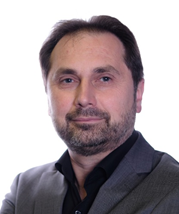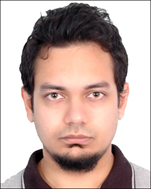Wireless Intelligent Secure Trustable Things: bringing IoT and AI together
Description
The digital transformation is going to change our society in almost every aspect. The conjunction of wirelessly connected cyber-physical systems with powerful edge and cloud applications brings along the industrial internet of things (IIoT), thus pushing digitalization not only into our home and our cities but also into our industry. The next step will bring Artificial Intelligence of Things (AIoT) as the natural evolution for both Artificial Intelligence (AI) and Internet of Things (IoT), as they are mutually beneficial. AI increases the value of the IoT through machine learning by transforming data into useful information, while IoT increases the value of AI through connectivity and data exchange.
Among several issues to be solved to make this vision become reality, trust in a secure, safe and dependable operation in both AI and IIoT are probably the most important ones.
In this workshop we will highlight recent advances in secure and trustable wirelessly connected IIoT as well as explainable, safe and secure AI methods, and mutual benefits from combining these approaches. This workshop is organized by the pan-European research project InSecTT (https://www.insectt.eu/), which stands for Intelligent Secure Trustable Things, combining effort of 52 key partners from 12 countries (EU and Turkey). The project aims at creating trust in AI-based intelligent systems and solutions as a major part of the Artificial Intelligence of Things (AIoT).
It will provide intelligent, secure and trustworthy systems for industrial applications as well as comprehensive, cost-efficient solutions of intelligent, end-to-end secure, trustworthy connectivity and interoperability at high Technology Readiness Level (TRL 6-7) to bridge the last mile to market implementation. InSecTT solutions shall be demonstrated in well-known real-world environments like trains, automobiles, airports and the health sector.
In this workshop, the InSecTT consortium explicitly invites contributions from outside InSecTT to complement the research within the project with a strong “outside-in view” to stimulate discussions and further research and also raise awareness about the importance of the topic. Therefore, we call for contributions from both, industry and academia. With respect to applications, we target industrial domains like automotive, aeronautics, building, health, robotics, smart manufacturing, etc.
The Workshop will be focusing on AI/ML based Solutions, Methods, Demonstrations (typical on higher TRL) covering theoretical and implementation aspects of security, privacy, safety and trust for IIoT ) for the following topics, but not limited to:
- Advanced wireless sensor networks (WSN) and IIoT concepts for industrial use cases in domains like automotive, aeronautics, building, health, robotics, smart manufacturing, with the focus on one or more of the following attributes: security, safety, reliability, trustability
- Innovative energy-constrained and autonomous IIoT components
- Dependable WSN with enhanced energy efficiency, robustness and quality-of-service
- Physical layer and out-of-band security in WSN applications
- AI-improved physical layer
- Routing and scheduling algorithms for reliable real-time WSNs
- Secure identification, authentication, authorization and communication in WSN
- Trust anchors and trust indicators for secure IIoT systems
- Edge and Cloud computing services for safe and secure connected mobility applications
Chairs
Hans-Peter Bernhard, Silicon Austria Labs GmbH and Johannes Kepler University
 Hans-Peter Bernhard (Senior Member, IEEE) received the master’s degree in electrical engineering and the Ph.D. degree in technical sciences from Technische Universitaet (TU) Wien with honors 1992 and 1997, respectively. He was Assistant Professor with TU Wien until 1998 and joined the JKU as a Lecturer in 1999. In 2014, he started as Senior Scientist at Johannes Kepler University and at Silicon Austria Labs in 2018 as Principal Scientist and Head of Research Unit Wireless Communications. He has been a visiting researcher with the Prague Academy of Sciences and the University of Cambridge. His research interests include the design and analysis of time sensitive communication systems focused to resilient solutions. He has given several invited talks on various aspects of wireless factory communication and is active in organizing IEEE and ACM conferences, workshops in various chair roles and member of IEEE IES TC-FA and TC-II.
Hans-Peter Bernhard (Senior Member, IEEE) received the master’s degree in electrical engineering and the Ph.D. degree in technical sciences from Technische Universitaet (TU) Wien with honors 1992 and 1997, respectively. He was Assistant Professor with TU Wien until 1998 and joined the JKU as a Lecturer in 1999. In 2014, he started as Senior Scientist at Johannes Kepler University and at Silicon Austria Labs in 2018 as Principal Scientist and Head of Research Unit Wireless Communications. He has been a visiting researcher with the Prague Academy of Sciences and the University of Cambridge. His research interests include the design and analysis of time sensitive communication systems focused to resilient solutions. He has given several invited talks on various aspects of wireless factory communication and is active in organizing IEEE and ACM conferences, workshops in various chair roles and member of IEEE IES TC-FA and TC-II.
Leander B. Hörmann, Linz Center of Mechatronics GmbH
 Dr. Leander B. Hörmann received his Dipl.-Ing. (equivalent to MSc.) in Telematics and his Dr.techn. (comparable with PhD.) in Electrical Engineering from Graz University of Technology, Austria, in 2010 and 2013, respectively. He joined the Linz Center of Mechatronics GmbH, Austria, in 2014 as senior researcher. Currently, he is leading of the team Industrial Internet of Things and coordinates research and development on this area. He has risen significant funding and has been actively involved in national and EU projects such as ASSET, SCOTT, and InSecTT. His main research interest is on system architecture of wireless sensor networks with special focus on cyber security, ultra-reliable, low latency, and low power communication protocols, ultra-low power electronics, and energy harvesting.
Dr. Leander B. Hörmann received his Dipl.-Ing. (equivalent to MSc.) in Telematics and his Dr.techn. (comparable with PhD.) in Electrical Engineering from Graz University of Technology, Austria, in 2010 and 2013, respectively. He joined the Linz Center of Mechatronics GmbH, Austria, in 2014 as senior researcher. Currently, he is leading of the team Industrial Internet of Things and coordinates research and development on this area. He has risen significant funding and has been actively involved in national and EU projects such as ASSET, SCOTT, and InSecTT. His main research interest is on system architecture of wireless sensor networks with special focus on cyber security, ultra-reliable, low latency, and low power communication protocols, ultra-low power electronics, and energy harvesting.
Ashutosh Simha, Delft University of Technology, Netherlands
 Ashutosh Simha graduated obtained his doctorate from the Indian Institute of Science in 2018, where his thesis focused on Riemannian geometric control methods for underactuated mechanics with applications to a class of UAV control problems. He then worked as a postdoctoral researcher at the Tallinn University of Technology, Estonia until 2020 where he worked on observers for nonlinear systems and underwater and amphibious robotics. He is now employed at the Delft University of Technology where his work focusses on networked robotics and intelligent control. In 2016 he was the recipient of the prestigious GE Edison challenge award. He has also contributed to key projects for the Indian Space Research Organisations and has consulted for Indian defense research establishment.
Ashutosh Simha graduated obtained his doctorate from the Indian Institute of Science in 2018, where his thesis focused on Riemannian geometric control methods for underactuated mechanics with applications to a class of UAV control problems. He then worked as a postdoctoral researcher at the Tallinn University of Technology, Estonia until 2020 where he worked on observers for nonlinear systems and underwater and amphibious robotics. He is now employed at the Delft University of Technology where his work focusses on networked robotics and intelligent control. In 2016 he was the recipient of the prestigious GE Edison challenge award. He has also contributed to key projects for the Indian Space Research Organisations and has consulted for Indian defense research establishment.
Paper Scheduling
| Time (CEST) | Time (EST) | Description |
| 16:30 | 10:30 | Welcome and Introduction |
| 16:35 | 10:35 | Live Keynote 1: “Developing software for networked production automation IIoT systems” by Univ.-Prof. DI Dr. Alois Zoitl, Johannes Kepler University Linz, Austria |
| 17:00 | 11:00 | Q&A Paper 5218: “RSSI-Based Machine Learning with Pre- and Post-Processing for Cell-Localization in IWSNs” (Julian Karoliny, Thomas Blazek, Fjolla Ademaj, Hans-Peter Bernhard, Andreas Springer) |
| 17:05 | 11:05 | Q&A Paper 5219: “A Review of Confidentiality Threats Against Embedded Neural Network Models” (Raphaël Joud, Pierre-Alain Moëllic, Rémi Bernhard, Jean-Baptiste Rigaud) |
| 17:10 | 11:10 | Q&A Paper 5222: “An Overview of Laser Injection Against Embedded Neural Network Models” (Mathieu Dumont, Pierre-Alain Moëllic, Raphael Viera, Jean-Max Dutertre, Rémi Bernhard) |
| 17:15 | 11:15 | Q&A Paper 5243: “Detecting Network Intrusion Using Binarized Neural Networks” (Jure Vreča, Iva Ivanov, Gregor Papa, Anton Biasizzo) |
| 17:20 | 11:20 | Live Keynote 2: “Empowering Artificial Intelligence Against Adversarial Patterns in the IoT Sensing Systems” by A. Prof. PhD., P.Eng. Burak Kantarci, University of Ottawa, Canada |
| 17:45 | 11:45 | Q&A Paper 5257: “Cooperative Vehicle Platoon Intra-Communications Over Space-Time Correlated Rice Fading Channels with Co-Channel Interference” (Ramiro Sámano-Robles) |
| 17:50 | 11:50 | Q&A Paper 5258: “In-Tunnel Multi-Ray Analysis for LOS V2V Links with Multiple Antennas” (Miguel Gutiérrez Gaitán, Ramiro Sámano-Robles) |
| 17:55 | 11:55 | Q&A Paper 5264: “Heart Watch: Dynamical Systems Based Real Time Data Driven ECG Synthesis” (Ashutosh Simha, Suryansh Sharma, Sujay Narayana, R. Venkatesha Prasad) |
| 18:00 | 12:00 | Q&A Paper 5265: “A First Step Towards Holistic Trustworthy Platoons” (Ali Shoker, Peter Moertl, Ramiro Sámano-Robles) |
| 18:05 | 15:05 | Panel Discussion |
| 18:25 | 12:25 | Summary & Closure |
Speakers
Burak Kantarci, University of Ottawa
Burak Kantarci is an Associate Professor and the Founding Director ofthe Next Generation Communications and Computing Networks (NEXTCON)Research Lab and the Smart Connected Vehicles Innovation Centre (SCVI)at the University of Ottawa. Dr. Kantarci holds a Ph.D in computer engineering; and he is a globally recognized researcher particularly in mobile cloud computing, mobile crowd-sensing and AI-driven solutions for secure and trustworthy cyberspace. Dr. Kantarci is the co-author of over 200 publications in established journals and conferences, and 13 book chapters. He is well known for his contributions to the quantification of data trustworthiness in mobile crowd-sensing (MCS) systems, and game theoretic incentives to promote user participation in MCS campaigns with high value data; as well as AI-backed access control, authentication and machine learning-backed intrusion detection solutions in sensing environments. Dr. Kantarci served as the Chair of IEEE Communications Systems Integration and Modeling Technical Committee, and has served as the Technical Program Co-Chair/ Symposium Co-chair of more than twenty international conferences/ symposia/ workshops including IEEE Global Communications Conference (GLOBECOM) – Communications Systems QoS, Reliability and Modeling (CQRM) symposium. An Editor of the IEEE Communications Surveys and Tutorials, IEEE Internet of Things, Elsevier Vehicular Communications, an associate editor for IEEE Networking Letters, an area editor for IEEE Transactions on Green Communications and Networking, and an associate editor for IEEE Access. Dr. Kantarci is a Distinguished Speaker of the Association for Computing Machinery (ACM), senior member of ACM, and senior member of the IEEE.
Title: Empowering Artificial Intelligence Against Adversarial Patterns in the IoT Sensing Systems
Abstract: Despite several benefits of services and applications that everage IoT sensing, cyber weaknesses are inevitable due to existing vulnerabilities in wireless networks. With massively connected nodes contributing to an IoT network, the cyber threat surface leads to more nodes becoming target points to enter an IoT network. Three pillars contribute to this keynote: First, vulnerabilities and countermeasures in IoT cybersecurity will be revisited to present the state of the art in machine learning-based intrusion detection. Next, we will switch gears to overview adversarial intelligence with the aim of anticipating the threats in IoT sensing systems. A specific use case, particularly, mobile crowd-sensing under the IoT ecosystem will be used to cover the adversarial aspects focusing on trustworthiness issues. The keynote will wrap up by elaborating on the open issues, challenges and future directions in this field.


